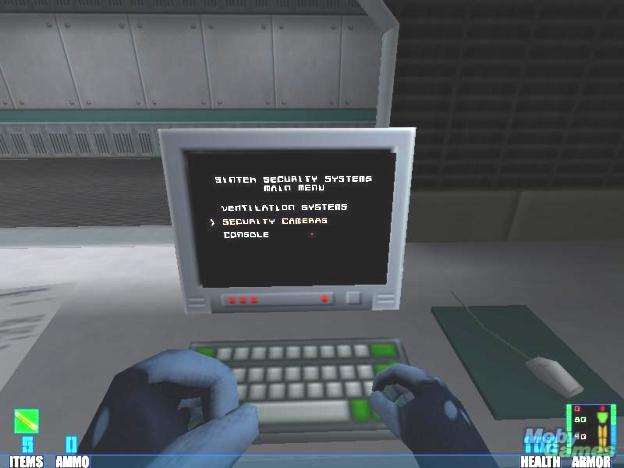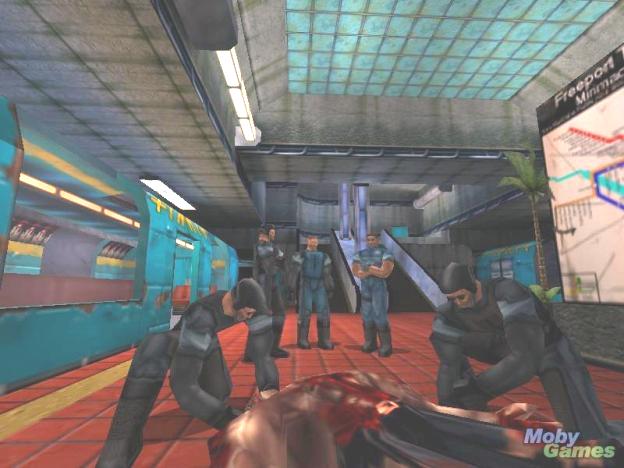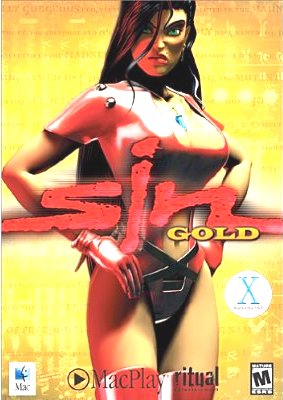Retrospective: SiN (1998 PC FPS)
 Context is everything. I hadn’t touched SiN since replaying SiN Gold when it was released for the Mac in 2000. Then they released the first ‘episode’ of SiN Episodes, called ‘Emergence‘ in 2006, which came with a Steam copy of ‘SiN 1′ as it was called. Naturally I played some then as I waited for the release of the episode, but didn’t make it all the way through. Since it is now ten years since the original release, I thought it only appropriate that I should do a Retrospective for a franchise that has spent its’ life in the shadow of Half Life.
Context is everything. I hadn’t touched SiN since replaying SiN Gold when it was released for the Mac in 2000. Then they released the first ‘episode’ of SiN Episodes, called ‘Emergence‘ in 2006, which came with a Steam copy of ‘SiN 1′ as it was called. Naturally I played some then as I waited for the release of the episode, but didn’t make it all the way through. Since it is now ten years since the original release, I thought it only appropriate that I should do a Retrospective for a franchise that has spent its’ life in the shadow of Half Life.
I say that ‘context is everything’ because this is the first time I have had the opportunity to truly look at this game in the context of all of the other shooters released in the 1998 time frame. Sure I played it sometime around when it was released, but my life was so scattered because when this game was released we had ‘two kids under two’ … so I am happy to have remembered to buy and play the game at that point!

The way I have recently been replaying games means being able to objectively evaluate SiN against its’ peers of the ‘Class of 98’ – games like Unreal, Jedi Knight and Mysteries of the Sith, Quake II, and of course Half-Life. Before I get into detailed comparisons and an evaluation of whether SiN’s life in the shadow of Half-Life is deserved, let’s look at the Good, Bad and Ugly of this classic shooter.
Good: Branching levels. The way in which you accomplish things in one area impacts where you go next. If you succeed at stealth you can get a different level progression than if you just blast through with the alarms sounding.

Good: Interactivity. Most stuff you’d find in a FPS in 1998 was just for show. Occasionally you could destroy something, but it was rare. SiN integrated destroyable elements and environmental interactivity nicely within what was possible at the time.
Good: FPS Innovations. Many things you take for granted now in most FPS games were fairly rare in 1998, such as stealth, underwater areas and harpoons, sniper rifles, and so on. While not groundbreaking in any of these areas, it was nice to see so many inclusions of ‘leading edge’ features.
Good: Music. In many online-centric shooter games, players simply mute the game soundtrack and put on pumping music to fuel them through the carnage. In this game – that IS the soundtrack. I can’t remember if the original sounded so good, but I do know that I thoroughly enjoyed blasting the music the whole way through this time.

Bad: User Interface. It is nice that you can log in as different users and have different visuals, controls, and so on. However, having it go all the way to the first screen is just strange. I used a login other than ‘Blade’ and always had to re-login to play, it never remembered that I was the only user with a save game, for example. And the mouse-unfriendly menu system is unforgivable for a 1998 game … though it seems to be more common in this new port-ladel era.
Bad: Bland level design. You will see the same thing again and again and again and … well, you get the picture.
Bad: Dumb enemies. All shooter enemies are dumb, and going back in time just serves to show how much less dumb they are now. SiN’s enemies stand out for their dumbness even after blasting my way through herds of brain-dead stormtroopers!

Ugly: ‘Smack Talk’. You are battling through a chemical factory to uncover a nefarious plot, so what does Blade say when he kills someone? ‘School’d ya!’ That is right – time and again you are treated with lines that sound like they are out of a typical deathmatch game played in the office of the developers back then.
Ugly: Blockheads Part Deux. I complained how the graphical elements of Unreal had not aged at the same rate. In SiN, everything looks a decade old, but the characters are extra ugly for some reason.
Ugly: Stale gameplay. The core shooter element feels more a part of the Duke Nukem 3D era than the post-Quake 2 era.
Ugly: Load Times. It is hard for me to believe that I *still* get load times more than 30 seconds long a decade later … I timed it and SiN areas load slower than those on the (infamously slow loading) Postal 2 … which was released five years later!

Ugly: Graphical oddities. In what is a very rare occurance, I was unable to snap screenshots using any of the 3 methods I have used through the years. The best I could get was completely black screens at full resolution. It is yet another way the game feels more like a 1996 game than a late 1998 release.
Ugly: Alexis Sinclair. OK, Alexis herself is certainly not ugly, Ritual made sure of that – but the concept is quite ugly. Sure she got a Source-engine upgrade in SiN Episodes in 2006, but the intent was there back in 1998 – Sinclair was smart, evil and impossibly proportioned. They knew that the sex-factor would attract the core audience of mostly male FPS gamers. Look no further than the boxart.

The bottom line is this: SiN is a pretty good shooter with a cliched plot and cardboard cutout characters that has not aged well.
So, how does it compare to the rest of the ‘class of 98’? Not very well at all. Indeed, pretty much every other shooter mentioned above makes SiN feel antiquated. The narrative style in Half-Life and the Jedi Knight games flows much more naturally and immerses you in the world. The graphics of Unreal have scaled much better – even when playing SiN from the Source release! All of that would be forgivable if SiN retained some fun as a thrilling shooter, but it doesn’t. The movement feels loose, the aim is sloppy, and the enemies are dumb meat-bags who just absorb bullets. I criticized Unreal for having levels that felt too much like they were prepping for deathmatches, but what SiN does is much worse – it wraps a story around levels that makes sense to that story, then give everything else a deathmatch feel. Having the last thing Blade says before the epilogue be simply a repeat of one of his taunts ‘die you ugly SOB’ just accentuates the point further.
In the class of 1998, which was truly a great a great year in the history of shooters, SiN faded to the background despite the hype and the massive ‘sex sells’ campaign. In 2006 it once again failed to attract enough attention to get the episodic series continued. And looking back, fading in the background is just what it deserved. Few remember Eradicator from the Doom era or Chrome from more recent years – both were decent games that were fun to play but lacked enough distinctive features to differentiate themselves from the herd of other releases. SiN has spent a decade with fans shouting ‘unfair – we get ignored because of Half-Life‘. And while I have had some sympathy due to the fact that SiN is a decent game, the time has come to tell those fans to just be quiet already. SiN is a decent shooter, but would not even quality as one of the top-5 FPS games released in 1998.





September 28th, 2008 at 11:28 am
This was the first real year of my career. A very exciting time to be a game journalist and the best time ever to be a PC game journalist. Best of all, for me, I reviewed so many of the top titles. It was a glorious time. I’m tired just thinking about it. Really.
September 29th, 2008 at 6:28 am
What are your recollections of SiN? I have to say that it has been very interesting going back and replaying these games together like we would have a decade ago … hindsight provides some interesting perspective on those games … and the current ones.
I feel like playing these has dampened my enjoyment of Crysis: Warhead … it is good and solid, but I feel our disagreement about the original has lessened 😉
February 8th, 2015 at 2:34 am
I’m years late to the party, but the inaccuracies must be cleaned up regardless. The review misses the obvious factual point: Everything that Half-Life does has been subsequently copied and superseded a guzzilion times over. Meanwhile Sin’s core features remain unique.
I’ll just copy/paste the points over from another forum discussion on Sin vs Half Life:
•Can you skip a level in HL?
•Can you go back to the earlier location as a result of failing a mission?
•Can you go to the alternative level as a result of newly discovered information?
•Do you ever have alternative entrance/exit points in HL?
And how many modern games can you name that do all the above?
Finally, after almost 17 years worth of hindsight, the debate settles.